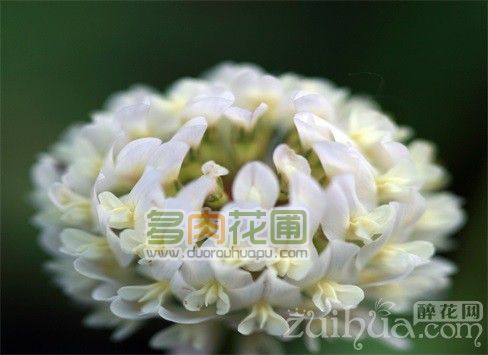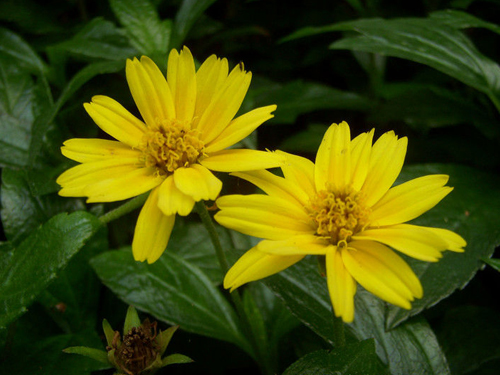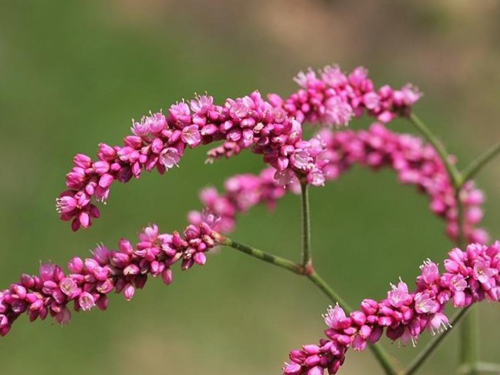Cultivation and management of white clover (Trifolium repens, Trifolium repens)
White clover (white clover, white clover)
Scientific name: trifolium repens
Aliases: White clover, clover, Holland warping, alfalfa, golden flower, clover, clover
Family and genus: mimosa family
Morphological features: perennial evergreen herbs. Tufted, 25-50 cm tall. Palmately 3-foliolate, Obovate, margin serrulate, apex emarginate, base cuneate, middle leaf traversing-white stripes. Inflorescences axillary, tall above foliage, white.
Ecological habits: heat-resistant, cold-resistant, drought-resistant, salt-intolerant, light-resistant and half-shaded. Resistant to trampling.
Cultivation and management: White clover likes light and warm and humid climate, the most suitable temperature for growth is 20-25 degrees Celsius, can tolerate half-shade, has strong adaptability. It is widely cultivated in the Yangtze River Basin of China and can remain evergreen in winter. Soil requirements are not strict, as long as good drainage, all kinds of soil can grow, especially rich in calcium and humus clayey soil.
Florescence: April to November.
Flower words: three leaves represent prayer, hope and love respectively, and clover with four leaves and above represents happiness.
Garden use: long flowering period, strong reproduction and good covering effect. Courtyard, square, forest edge, sparse forest grass underground large area planting, slope protection.
Economic value: this species is an excellent forage, rich in protein and minerals, resistant to cold and heat, and can adapt to both acidic and alkaline soil. it is a promising species in China. It can be used as green manure, embankment protection grass, lawn decoration, honey source and medicinal materials. Foreign scholars often divide this species into subspecies, varieties and cultivated varieties bred in agriculture according to their geographical and morphological differences.
Species identification: same genus species-t.pratense flowers purplish red. Often mixed with Trifolium repens.

Growth habit
Soil: do not have high requirements for soil, especially like clay acid-resistant soil, can also grow in sandy soil, pH 5.5-7, or even 4.5 can grow, weak-acid soil is not resistant to salt and alkali, pH 6-6.5 is beneficial to root nodule formation.
Light: Trifolium repens is a long-day plant, not resistant to shade, and the number of flowers can increase after more than 13.5 hours of sunshine. Trifolium repens prefers sunny open land and has obvious phototropic movement, that is, the leaves can move with the change of weather and daily time, as well as the angle and position of the light source.
Drought resistance: it has a certain drought resistance, the high temperature of about 35 ℃ will not wilt, the optimum temperature for its growth is 16-24 ℃, it likes light, it grows luxuriantly and has strong competitive ability in the place with plenty of sunshine.
Cold tolerance: Trifolium repens likes warm and humid climate, and is not tolerant to drought and long-term stagnant water. It is most suitable for seeds to germinate at 1 ℃ ~ 5 ℃ in the area with annual precipitation 800~1200mm, and the optimum temperature is 19 ℃ ~ 24 ℃. The winter can be safely survived under the conditions of snow thickness up to 20cm, snow cover for 1 month and air temperature of-15 ℃. It can also pass the summer safely when the average temperature is ≥ 35 ℃ and the transient extremely high temperature reaches 39 ℃.
Artificial cultivation
Sowing and reproduction
1. Soil preparation and fertilization
Trifolium repens L. has fine seeds, slow growth in seedling stage, and weak competitiveness with weeds. Therefore, it is necessary to prepare the soil carefully and remove weeds before sowing. When planting in places with heavy soil and heavy precipitation, ditches should be opened to facilitate drainage. At the same time, the soil preparation should apply sufficient base fertilizer, generally applying 20kg of calcium, magnesium and phosphate fertilizer per mu, stable fertilizer should be applied at the same time for the soil which is very lack of organic matter, and 50kg lime per mu should be added to the soil with excessive acidity. If the source of fertilizer is difficult in mountainous areas, charred mud ash and plant ash can be made on the spot as seed fertilizer, and retting fertilizer made from weeds and leaves as base fertilizer.
2. Mix with rhizobium
The rhizobium of white clover is the same as that of red clover and strawberry clover. Every 10 grams of rhizobium and 1 kg of white clover seeds are mixed with a small amount of water before sowing.
3. Fine sowing
Seeds can be sown in both spring and autumn. Spring sowing in southern China is before mid-March, and autumn sowing should be before mid-October. The sowing rate is 0.25 to 0.5 kg / mu. The mixed sowing of Trifolium repens and grasses such as ryegrass, orchard grass and cattail grass is suitable for the establishment of artificial grassland.
Cultivation techniques
Weeding: the white clover grass is covered all over the ground, so it is difficult to apply mechanical weeding, and manual pulling method is often used. Artificial weeding for 2 or 3 times in the same year can remove weeds and ensure growth. In general, after covering and weeding in the same year, weeds only occur sporadically in the following years, basically avoiding the harm of weeds.
Water management: Trifolium repens has strong drought resistance and poor waterlogging tolerance. The growth potential is more prosperous when the water is sufficient, replenish water properly when drought, and drain waterlogging and reduce waterlogging in time when Rain Water is too much, in order to facilitate growth. After the formation of the ping, in addition to the occurrence of extreme drought, generally do not water, in order to avoid Pythium wilt. The watering of Trifolium repens should be based on the principle of less times and more quantity.
Pest control
Stick leaf disease
A kind of disease caused by mycoplasma infection is common and serious in some areas. The disease results in abnormal leaves, narrow and long leaves, irregular edges and weak plant growth, which affects the ornamental value. The disease can be transmitted by contact or insect mediators such as leafhoppers, and the peak of the disease is from July to August.
In order to control the disease, we should do a good job in pastoral management, enhance plant disease resistance and control virus transmission media.
Dodder
Dodder seeds are very small in some areas, which can be carried by Trifolium repens seeds, form silk yellow after germination and growth, parasitic on the stem branches of Trifolium repens, and absorb its nutrients and water, resulting in nutrient deficiency, plant yellowing, growth hindrance and death in serious cases.
Prevention and control methods:
1. Strengthen quarantine to prevent dodder from spreading with the seeds.
2. In order to prevent the spread of dodder, the key to manual cutting or pulling out infected plants is to remove or cut dodder before setting fruit.
3. Chemical control, 1.5%-2% dinitroo-cresol and dinitrophenol solution can be sprayed.
Leaf spot disease
Including a variety of fungal diseases, such as Streptomyces leaf spot, coal spot, shell polycytic leaf spot, tail cell leaf spot and yellow spot and so on. Among them, creeping stalk mildew spot, coal spot and shell multicellular leaf spot are the most common, which produce a variety of disease spots with different shape, size and color on the leaves, resulting in leaf wilting and shedding. The disease is serious, such as improper lawn management, vigorous growth of plants, closed grass, poor drainage and so on. The peak of the disease is the high temperature and rainy summer and autumn, which can cause a large number of leaves to die and fall off.
Prevention and control methods: control the disease by selecting disease-free seeds, removing disease residues, doing a good job of management and protection, balanced fertilization, avoiding stagnant water and other measures, and timely spraying carbendazim, methyl thiophanate (methyl thiophanate), mancozeb and other fungicides.
That's all I know about white clover today. I hope it will be helpful for flower friends to read this article. If you want to know more about white clover, please continue to pay attention to the succulent flower bed, we will provide you with more related knowledge!
Introduction of the main value of white clover introduction of identification methods of white clover
White clover is one of the most widely used legume grasses in the world. It can be sown single or mixed with grasses. It is mainly used in economic forest intercropping, livestock, poultry and fish forage, soil and water conservation and landscape greening. What is the value of white clover. Come and learn from the editor.
Main value
Trifolium repens is rich in a variety of nutrients and mineral elements, and has high feeding, greening, genetic breeding and medicinal value. it can be used as green manure, embankment protection grass, lawn decoration, honey source and medicinal materials.
Economic value
Feed
Trifolium repens has good palatability and high digestibility, so it is favored by all kinds of livestock and poultry, and is suitable for raising cattle, sheep, grass carp and so on. The nutrient composition and digestibility were higher than those of alfalfa and red clover. On the natural grassland, the feeding value of the grass community also increased with the increase of the proportion of Trifolium repens, while the hay yield and seed yield varied with different regions. it had the characteristics of early germination, late decline and long grass supply season, and the grass supply season was from April to November in the south. The stem of Trifolium repens is creeping, the petiole is long, and the grass layer is low, so it feeds more on leaves and tender stems when grazing.
At the same time, with the increase of grass age, the decline rate of digestibility was slower than that of other grasses. Trifolium repens has the characteristics of trampling resistance, rapid expansion and strong ability to compete with weeds after forming a community, so it is mostly used for grazing. But moderate grazing is needed to facilitate the re-growth of Trifolium repens. When feeding, it should be fed with Gramineae forage, which can achieve the balance of carbon and nitrogen and prevent the bloating disease of Trifolium repens. In addition, the grass powder can be used as the raw material of compound feed.
Ecological ornamental
Trifolium repens has strong invasiveness and competitiveness, which can effectively restrain the growth of weeds without long-term pruning, extensive management and long service life, and has the effect of improving soil and soil moisture. It can be used for the establishment of green lawns such as gardens, parks, golf courses and so on.
Build lawn
The leaf color of Trifolium repens is beautiful, the green period is long, and the cost of planting and maintenance is low. It takes only 30 to 40 days from sowing to forming a flat, and it can be used continuously for 6-7 years or even 10 years. The fallen seeds have strong ability of self-sowing and reproduction. It is an excellent species of green and ornamental lawn, which can not only be planted in pieces, but also be mixed with trees and shrubs to form a hierarchical compound landscape. Mixed cultivation with other warm-season lawns can prolong the green period. The roots of Trifolium repens are developed, the lateral roots are dense, and the soil can be fixed, and the thick leaves can prevent Rain Water from scouring the soil and wind erosion, so the effect of water storage and soil conservation is obvious, so it is suitable to plant revetment on sloping land, embankments and lakes to prevent soil erosion. At the same time, it is easy to create a gorgeous and natural ecological landscape. Diseases and insect pests are not easy to occur, there are few weeds, and there is no need for manual impurity removal after the formation of the flat, which can effectively reduce the amount of weeding labor and the use of chemical herbicides.
Improve the soil and fertilize the field
There are a large number of nodules on the main root and lateral root of Trifolium repens, which can fix nitrogen in the air. There is no need to apply nitrogen fertilizer in the planting process, only some phosphorus and potassium fertilizer is needed to make the branches and leaves luxuriant. In slightly saline-alkaline soil, it is suitable to sow Trifolium repens after mixing seeds, which can promote the growth and development of its roots. The root system of intercropping in the orchard is mainly distributed in the soil layer of surface 15cm and will not compete for fertilizer and water with the fruit trees with deep roots. The characteristics of half-shade tolerance and rapid growth of Trifolium repens make it cover the ground of orchard, establish a single population advantage, prevent the growth of other weeds, especially inhibit malignant broad-leaf weeds such as Polygonum, Chenopodium, amaranth and ragweed, and reduce surface water evaporation. The exudates of grass roots and residual roots can input organic matter into the soil, which can alleviate the deficiency of fruit trees, promote the activity of soil microorganisms, improve soil, improve soil fertility and fertilizer use efficiency. The flower of Trifolium repens is a good source of honey, attracting bees, butterflies and other insects to help pollinate to improve the fruit setting rate, forming a virtuous cycle of fruit, grass, fertilizer and water ecosystem in the orchard.
Medicinal value
The whole herb of Trifolium repens L. has the effect of clearing heat and cooling blood, relieving nerves and relieving pain, expectorant and cough. It is reported in foreign clinical trials that the tincture of Trifolium pratense can be used to treat cold, and the whole herb tincture has the effect of astringent hemostasis and can be used as a medicine to stop bleeding and promote wound healing. It is also found that the isoflavones have anticancer effects. The macromolecular polysaccharides extracted from Trifolium repens have a series of medicinal and health functions, such as improving immunity, anti-tumor, anti-aging, reducing blood lipids and so on.
Identification method
Microscopic identification
Leaf cross section: a small amount of glandular hairs can be seen in the epidermis. The palisade tissue is composed of 2-3 rows of cells passing through the main vein, while the spongy tissue is composed of 3-5 rows of cells with large intercellular space. The main vein is a doubly tough vascular bundle.
Cross section of stem: covered with a few unicellular non-glandular hairs. The cortex is broad. There are 10 to 12 vascular vessels, there are many fibers on the outside of the phloem, and the xylem is continuously ringed. A small amount of calcium oxalate square crystals can be seen in the pith and rays.
Root cross section: the cortex is composed of several layers of parenchyma cells, in which several secretory cells gather and contain yellowish brown secretions.
Chemical composition
The leaves contain isoquercitrin, linolenic glycoside (linamarin) and lotaustralin.
The whole grass contains coumaroestrol (conmestrol), tocopherol (tocopherol), saponins and genistein (genistein). Genistein has hormone-like effect.
That's all I know about white clover today. I hope it will be helpful for flower friends to read this article. If you want to know more about white clover, please continue to pay attention to the succulent flower bed, we will provide you with more related knowledge!
- Prev

Cultivation and Management of Chrysanthemum morifolium in South America and its efficacy and use
Chrysanthemum morifolium (Dijinhua, South American chamomile) scientific name: wedeliatrilobata alias: Trifid Chrysanthemum, Dijinhua, Diandra (Yunnan), keel seven families: Compositae morphological characteristics: perennial herbs. Stems creeping, leaves opposite, ovate-lanceolate
- Next

Culture method of Polygonum polygonum (Polygonum orientalis, Polygonum orientalis, Dog tail Red)
Polygonumorientale: Polygonum orientalis, Polygonum orientalis, Polygonum davidii, Polygonum orientalis, Polygonum macrophyllum, Polygonum angustifolia, Polygonaceae: morphological characteristics of Polygonaceae:-annual herbs. Inflorescences drooping, reddish, red or white. Fruit spike red
Related
- Fuxing push coffee new agricultural production and marketing class: lack of small-scale processing plants
- Jujube rice field leisure farm deep ploughing Yilan for five years to create a space for organic food and play
- Nongyu Farm-A trial of organic papaya for brave women with advanced technology
- Four points for attention in the prevention and control of diseases and insect pests of edible fungi
- How to add nutrient solution to Edible Fungi
- Is there any good way to control edible fungus mites?
- Open Inoculation Technology of Edible Fungi
- Is there any clever way to use fertilizer for edible fungus in winter?
- What agents are used to kill the pathogens of edible fungi in the mushroom shed?
- Rapid drying of Edible Fungi

